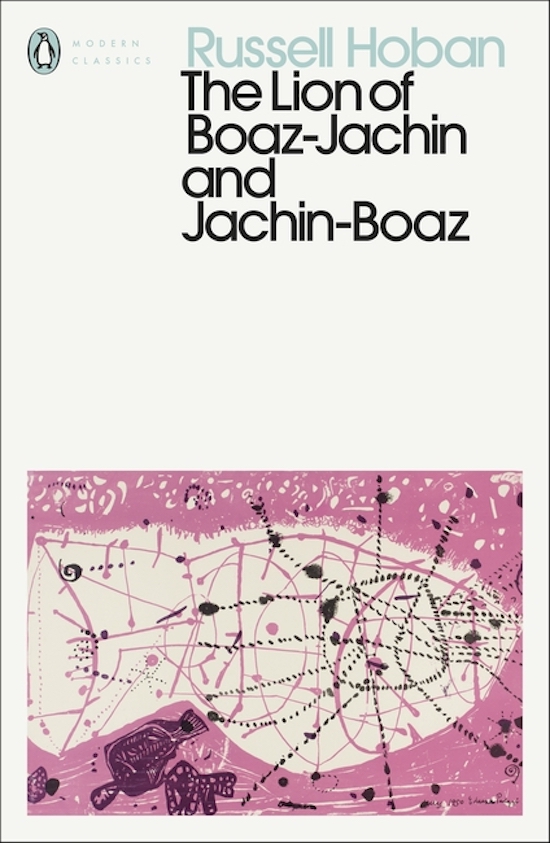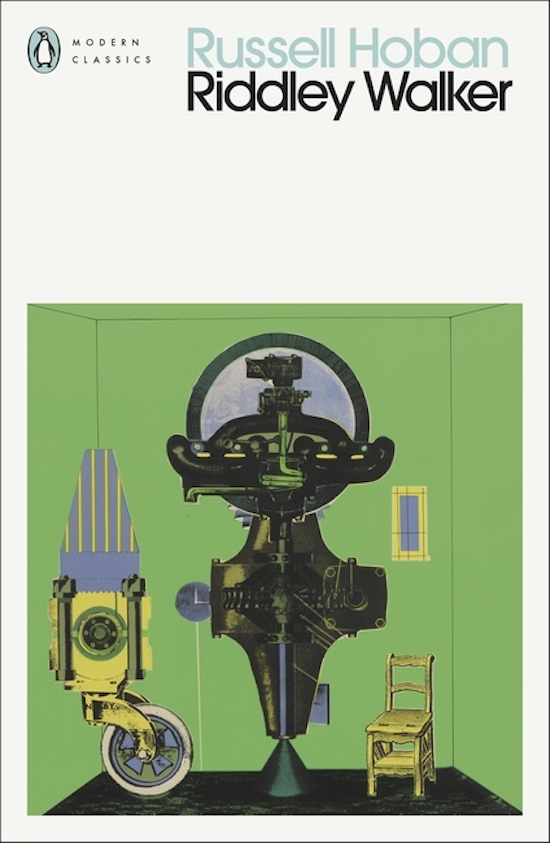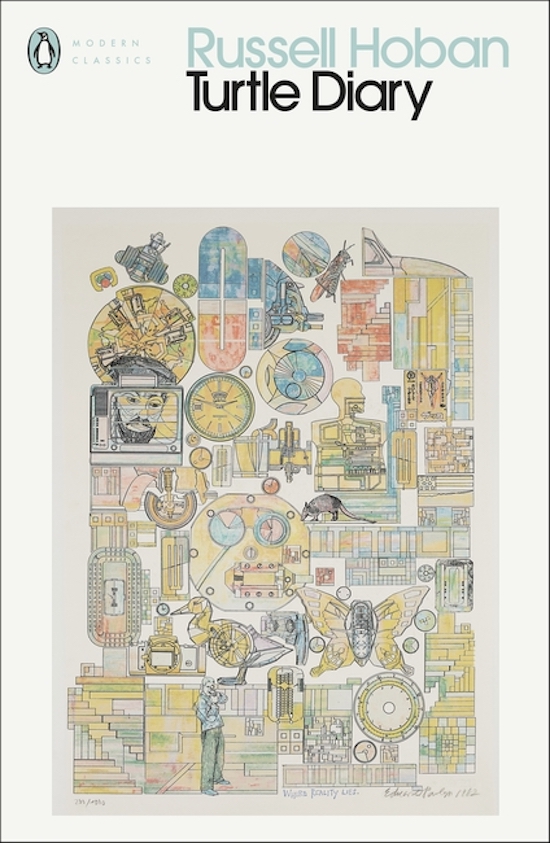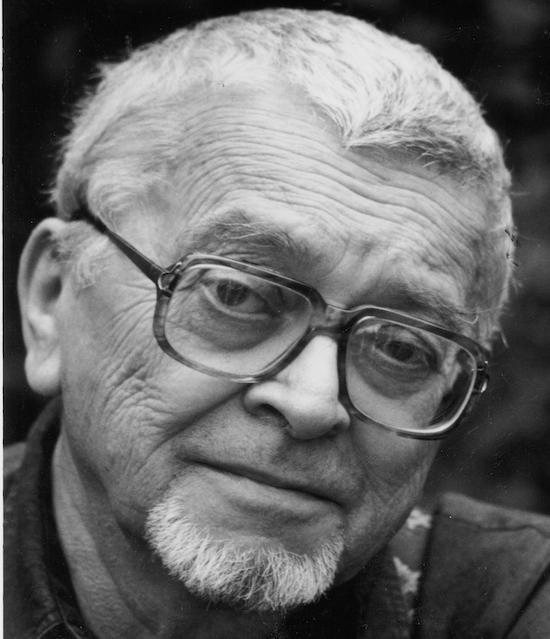Photo credit: Tana Hoban
William G, one of the two protagonists of Russell Hoban’s third novel Turtle Diary (1975), is walking home from work one evening. He notices a manhole cover for the first time. Its number is K257. At home he looks up K257 in a Mozart Companion and discovers that K257 is the Credo Mass in C. “Credo. I believe,” he says to himself. “What does the manhole cover believe, or what’s being believed down in the hole?… Now whenever I walk on that manhole cover it’ll say ‘I believe’.” As it does the very next morning.
William is, at best, ambivalent about this development. “I don’t like getting too many messages from the things around me”, he says. That is unfortunate for William because he is a character in a Russell Hoban novel, and in Hoban’s books everything is a transmitter of meaning in its own particular language, and everything is connected. And you might say the novels are as much about exploring that process of connection, of revelation and discovery, as they are explorations of character or expositions of plot.
Hoban is best known for his extraordinary 1980 novel Riddley Walker, which we’ll come back to later. But Penguin has now reissued all his first eight novels – which were first published between 1973 and 1998 – under its Modern Classics imprint, with covers adapted from the works of Eduardo Paolozzi. Hoban, who wrote sixteen novels in all and died in 2011, never quite escaped cult status while he was alive – “death will be a good career move for me” he told the Guardian in 2002 – and never really fitted into any comfortable publishing niche either. Will his works fare any better in the 2020s?
Hoban was born in Pennsylvania in 1925. After military service in Europe in World War Two he started his professional life as an illustrator, working in TV and advertising before turning to write children’s books at the very end of the 1950s. He continued to write them until his death, producing some sixty-five in total. One, The Mouse and His Child (1967) established his reputation as a writer capable of conjuring startling depths of insight, wit and intelligence from the simplest of premises. Its story, of a clockwork father-and-son mouse toy on a quest to recapture the site of their lost happiness, encompasses everything from reflections on the idea of the infinite to a pastiche of Samuel Beckett called ‘The Last Visible Dog’.
The success of that book enabled Hoban to move with his wife and four children to London. The move was not successful for anyone but Hoban himself, and his family returned to the United States in 1970. Hoban did not return with them. As the Sunday Times crisply put it in a 1980 profile, “One of the central facts of his own life is that he abandoned his first family.” That breach led directly to the writing of his first novel for adults, The Lion of Boaz-Jachin and Jachin-Boaz (1973), and informs several subsequent novels too. He soon married a young German woman, with whom he started a second family – again a situation he drew on in his early novels – and stayed in London for the rest of his life.
Boaz-Jachin and Jachin-Boaz – named for the pillars in the Temple of Solomon – are a father and son who live in an unnamed city somewhere in the Middle East in a world that is very much like our own except for one particular: there are no longer any lions. Boaz-Jachin is a map-maker whose life has been defined by his relationship with his own father. He has lost all desire, all sense of purpose, all connection with life. “Often he thought of death, of himself gone and the great dark shoulder of the world for ever turning away from the nothingness of him forever in the blackness.”

He has laboured over a master map to give to his son containing everything he thinks his son will want or need, but he abandons both wife and son, taking the map – taking his son’s future – with him. “I kept it for myself, kept it for finding what I’d never found,” he explains. He arrives in an unnamed city that is in all essentials London right down to “the statue of the man who had lost his head for some notion of the truth” – that is, Thomas More, whose statue can be found by the Thames in Chelsea, outside the church that he used to attend. (You don’t read much Hoban without discovering his fascination – just glimpsed here – with heads detached from their bodies, particularly when they still talk, and dismemberment as metaphor.)
Angry at this betrayal, the son, Jachin-Boaz, summons a lion back into the world, a lion whose prey will be his father. Then, himself abandoning his mother and his girlfriend, he sets out to find his father too. The lion appears to Boaz-Jachin in London. The question of the reality of the lion arises almost immediately. It is seemingly visible only to him. Nevertheless it claws him, and he must feed it. What kind of reality does it have then? “He did not know whether the lion was real in the sense that he himself and the shop and the street were real,” Hoban writes. “But he knew that the lion could kill him.”
It’s a reviewer’s cliché to describe a book as a meditation on its subject. But really, The Lion of Boaz-Jachin and Jachin-Boaz is just that. In deceptively simple prose of great precision and beauty, Hoban takes a series of ideas – about fathers and sons, about identity and forgiveness, about death and time, about finding and losing, about reality and language, estrangement and memory – and turns them over again and again and again, toying with them, pulling them apart, turning them inside out. The whole book becomes a web of densely interconnected images and metaphors through which dance all the meanings of lions and darkness, of maps and orange groves, of wheels and emptiness.
The lion, in particular, embodies two of Hoban’s key themes: first, that the reality we experience in the mind is the only reality we can know, and therefore anything that can be conceived has existence, irrespective of its material presence; and second, our impoverished capacity to describe and comprehend the larger reality, which for Hoban can never be contained in what he called the small language of words. The lion is simply itself, the perfect expression of the idea of lion-ness, fully alive and primed, hungry for life and death. “The lion was,” Hoban writes of him. “Ignorant of non-existence … the lion continued. He was intact, diminished by nothing, increased by nothing, absolute … known when there was knowledge of him, unknown when there was not. But always he was.” But the lion is also implacably, terrifyingly unknowable, with an intensity of selfhood, of being, that is far greater than the mere word ‘lion’ can contain, and far deeper than the momentary meanings he has for Boaz-Jachin and Jachin-Boaz.

Hoban said that all of his books were inspired by specific experiences he had had, or engagements with specific works of art. As he told the critic John Haffenden in 1981, “There’s a reservoir of all kinds of things waiting to find a channel to hook up with. With each of my novels some object or picture or experience or thing has provided the channel that hooked up with everything that was waiting to put itself together.” In the case of The Lion of Boaz-Jachin and Jachin-Boaz it was an Assyrian relief at the British Museum of King Ashurbanipal’s lion hunt, excavated from the king’s palace at Ninevah. The king and his men are in a chariot, the lion is leaping at them. There are two arrows and two spears deep in him. His jaws are clamped around the chariot’s wheel, as if to stop the chariot, to stop time and death too.
Readers of Hoban quickly discover that just as The Lion of Boaz-Jachin and Jachin-Boaz is bound together with metaphors, ideas and images, so his entire body of work is an exploration of a body of thought about life and death and the nature of consciousness and so on, expressed through encounters with a family of metaphors, myths, fictions, films, and other works of art which recur obsessively. There is a definite sense of things that, once they have got their teeth into Hoban, never let go. He returned to King Ashurbanipal’s lion hunt in 1998’s Mr Rinyo-Clacton’s Offer. In the intervening twenty-five years, readers met repeatedly with Hermes, Orpheus and Eurydice, with Medusa, with Vermeer’s The Girl With the Pearl Earring – and specifically the look in the girl’s eyes – with Luther’s hymn ‘A Mighty Fortress Is Our God’. with talking heads, with green turtles and sharks, with stones and mirrors, with bees, owls and lions, with the London Underground, with yellow A4 paper. It is nicely apposite, as Hoban was certainly aware, that another recurring interest is the idea of the infinitely recurring pattern; the repetitive motifs of Islamic art, in which the repetition is itself a form of beauty, were a particular obsession.
Again, that word ‘meditation’ comes to mind, but it’s worth saying that Hoban’s books are often as least as playful as they are profound. In Kleinzeit (1974) – at once a satire on the medicalisation of the human condition and an elucidation of the creative drive – body organs include the hypotenuse, the asymptotes, and the diapason, while symptoms range from partial eclipse to chronic ullage. Everything talks to Kleinzeit, from the bathroom mirror to the hospital bed, and he has long conversations with the concept of Hospital (“I haven’t any first or middle name,” Hospital tells him. “We big chaps just have one: Ocean, Sky, Hospital, and so forth.”), and, latterly, Death, who takes the form of a chimpanzee.
“Go away, he said. You’re not real, you’re just in my mind.
IS YOUR MIND REAL? said Death.
Of course my mind’s real, said Kleinzeit.
THEN SO AM I.”
It’s this sort of thing that sometimes gets Hoban accused of whimsy. But I’m not sure that’s right. His writing, even at its most fantastical, is too tight for that. And the fun he has with ideas and language is usually grounded in the serious concerns of the novel at hand. So while he’s not above low puns and wordplay – consider the publisher Reedham & Weap in The Medusa Frequency (1987), for example – he knows that how we describe ourselves, how we describe the world, is a life-and-death matter. In Fremder (1996), the eponymous hero’s grandfather, whose own parents died at Auschwitz, changed his surname from Gorenstein to Gorn when he moved to England. He thought it a less revealing name should someone come knocking in the night. “Gorn today; here tomorrow” he liked to say.
Another way of saying all this is that a Russell Hoban novel is not much like a novel by anyone else. His publisher at the time, Tom Maschler, who dropped him after Mr Rinyo-Clacton’s Offer, seemed to take a dim view of this. “I think there might be a clue to his character in his total failure to admire any contemporary writers whatsoever,” Maschler once said. “Really a writer should be interested in other writers.” But from this distance, it looks much more like a strength than a weakness. While some of the furniture of these books has of course become period detail: the Apple II computer, say, green letters blinking out of the darkness of its screen, on which Hermann Orff, the narrator of The Medusa Frequency, himself a lapsed novelist, types his work. (The boundary between Hoban and his narrators is porous, to say the least.) But most of them, whenever they are set, exist in a kind of perpetual present tense of Hoban’s alertness and intelligence.

Hoban’s most conventional novel is probably Turtle Diary (1975); it’s certainly his most extended foray into exploration of character. (It’s surely not a coincidence that Turtle Diary is the only Hoban novel to be adapted into a film.) But even then it is not much like the kind of contemporary novel that Hoban himself, in an essay titled ‘The Bear in Max Ernst’s Bedroom’, dismissed as “simply the conveying of chunks of experience wrapped up in some kind of story”. It tells, in alternating chapters, the stories of William G and Neaera, unknown to each other when the book begins, two middle-aged people somewhat lost in the midst of life – people for whom “the great heavy boot of the past is planted squarely in [their] back” – who decide to steal the two green turtles from London Zoo and release them into the sea. Green turtles, William says, considering their greatness confined in the smallness of the zoo’s tank, “swim 1,400 miles to breed and lay their eggs on Ascension Island in the South Atlantic… Ascension Island is only five miles long. Nobody knows how they find it.” Thirty-odd pages later, Neaera completes the thought for him. “What more can you do to a creature, short of killing it, than prevent it from finding what it can find?”
Like many of his books, Turtle Diary has a kind of quest narrative, but the unravelling of the quest is, if not exactly a MacGuffin – because both the turtles and their planned release do have their own intrinsic meanings – then no more than one reflection of the book’s wider concerns. The story, in Hoban’s terms, is not necessarily where the action is. “A book is an action – something that is moving,” he told Haffenden, “and whether it happens pre-eminently as character and event or as thought and elucidation doesn’t matter.” The eponymous narrator of ,Pilgermann (1983) takes the idea even further: “A story is what remains when you leave out most of the action.” For Hoban the real action to be written about is the processes of experience: how the mind receives and understands the wordless mysteries of existence, how everything that is relates both to everything else and to the lost and broken oneness of creation.
Turtle Diary, again like most of his books, also has a breadth of reference that on paper ought to overwhelm his characters. By way of illustration, an incomplete list of works or writers mentioned in the book would include: John Clare, the Burt Lancaster film The Swimmer, Gerard Manley Hopkins, Beowulf, Milton’s ‘Lycidas’, Edward Lear’s The Yonghy-Bonghy-Bo, William Blake, Basho, The Invisible Man, Crime and Punishment, The Duchess of Malfi, ‘The Rites of Spring’, King Kong, Tolstoy, Moby Dick, The Four Quartets, and Plutarch. But what at first sight might feel like digressions are always both elegantly woven into the thinking of his characters and thematically relevant. “There are no digressions, it’s all one thing,” Hermann Orff says pointedly in The Medusa Frequency.
It’s not just the ease with which big ideas swim through the prose – surfacing with a seeming randomness that is anything but – that makes Hoban such a compelling writer. And it’s not just the economy with which he achieves his effects (the longest novel here, Pilgermann, comes in at 260-odd pages). It’s the ability to shape a fast-paced narrative that isn’t driven by either a chain of events or the choices of the characters. Instead, the narratives proceed along chains of thought and through intuitions and apparently random connections. The reader’s experience is one of slow-moving astonishments, epiphanies in standard time; and Hoban leads you through the maze of associations so seamlessly you barely notice the direction of travel. He customarily makes the most audacious of imaginative leaps seem somehow inconspicuous.
Take, for example, the head of Orpheus in The Medusa Frequency appearing in the form of, among other things, a grapefruit, a football, and a cauliflower. Or the robot on a deserted asteroid which recites the first of Rilke’s Duino Elegies to Fremder in the voice of his dead mother. Or the Bosch-inspired scenes of Pilgermann, set in 1097 during the Crusades, in which, among other things, Death rapes a group of child pilgrims, impregnating them with their own small deaths, which will come to full term in due course.
These are all fantastical moments, but you would hesitate, I think, to call Hoban a fantasy writer. That’s partly because when he writes about the material world he does so with such clarity and intensity of perception that it somehow underwrites the most baroque of imaginative extravagances. But I would also say it’s partly because the world-building that he does occurs at least as much in the minds of his characters as it does in the perceptible world around them. The head of Orpheus may not necessarily be real in the way the District Line or a November evening are real – and it is, in any case, just words on a page. But Hoban makes it as real as any hallucination that lives in the memory, any terror, any aloneness, any loss that lives in the mind. And those are the kinds of realities – wordless, immaterial, unknowable in their reaches – in which Hoban excels.
Having said that, it’s hard to call Hoban’s masterpiece, Riddley Walker, anything but a fantasy novel, although that feels altogether too small a term for a book of such mythopoeic force. It’s not just the word ‘fantasy’ that is too weak, either; calling Riddley Walker a novel is like calling Paradise Lost a poem. The generic nature of the term simply isn’t sufficient to comprehend the thing it attempts to describe. The novel is set in Kent 2,347 years after a nuclear holocaust. Humanity is reduced to small huddled communities of mostly nomadic hunter-gatherers, some of whom are beginning to settle again. Political authority over these communities, such as it is, is conveyed through a puppet show, ‘the Eusa story’, a mythic retelling of how man’s fall which somehow combines the legend of St Eustace, atomic theory, and the figure of Christ, “the Littl Man, the Addom”. After the death of his father, the book’s eponymous narrator, a twelve-year-old boy-become-man, runs away from his community and embarks on a journey that is in part a quest to recover man’s lost knowledge, and in part a reckoning with the nature of that knowledge, and the nature of humanity, twice fallen.

What makes Riddley Walker such a triumph is the language it’s written in, a debased version of English of Hoban’s creation, which nevertheless has its own lyrical rhythms and power. Here’s an extended passage from one of the book’s stories-within-a-story, ‘Why the Dog Wont Show Its Eyes’:
Every thing has a shape and so does the nite only you cant see the shape of nite nor you cant think it. If you put your self right you can know it. Not with knowing in your head but with the 1st knowing. Where the number creeper grows on the dead stoans and the groun is sour for 3 days digging the nite stil knows the shape of its self tho we dont. Some times the nite is the shape of a ear only it aint a ear we know the shape of. Lissening back for all the souns whatre gone from us. The hummering of the dead towns and the voyces before the towns been there. Before the iron ben and fire ben only littl. Lissening for whats coming as wel.
It’s a language full of corruptions that are also neologisms – suching waytion, tryl narrer, plomercy, trants mission, sharna pax, the lovely phrase “whats in us lorn and loan and oansome”, and so on – the full meanings of which are both apparent and elusive, easy to grasp and yet in some sense ungraspable. Reading it is like walking over rubble: it’s simple enough to do when you’ve found your feet, but you still have to watch your step. And if sometimes you have to strain for the meanings of words or phrases, you are doing no more than Riddley is doing, piecing the meaning of the world together step by step, young feet in old footsteps.
One of Hoban’s most persistent themes is the idea of the inexpressible: the inability of words to contain all the meanings of anything they describe, the inadequacy of language to comprehend the darkness and mystery out of which we come and into which we go. “Reality is ungraspable,” he wrote in the Foreword to his 1992 collection of short stories and essays, The Moment Under the Moment. “[O]nly the strangeness of it can be taken in and that’s what interests me: the strangeness of human consciousness; the strangeness of life and death; the strangeness of what the living and the dead are to one another; and the strangeness of ideas … that seem to have been with us from long before the stories of them happened. The real reality, the flickering of seen and unseen actualities, the moment under the moment, can’t be put into words; the most a writer can do – and this is only rarely achieved – is to write in such a way that the reader finds himself in a place where the unwordable happens off the page…”
These ideas finds their most profound expression in Riddley Walker precisely because it its written into the space between words and their meanings. Hoban places you right inside the mystery of language; there is no reading experience like it.
Reading these novels again in sequence, I’ve been thinking a lot about that Assyrian lion – intact, diminished by nothing, increased by nothing, absolute – holding the chariot wheel by its teeth, the embodiment of life and death, beauty and terror, looking without fear into the darkness. The idea of it – tawny in its hunger and intensity – is alive in almost everything Hoban wrote, because Hoban’s writing is always alive to the flickering, vertiginous immediacy of the moment in all its unknowable depth and possibilities.
“Who knew what might happen at the typewriter?” Neaera asks towards the end of The Turtle Diary. If it’s Russell Hoban writing, almost anything.


